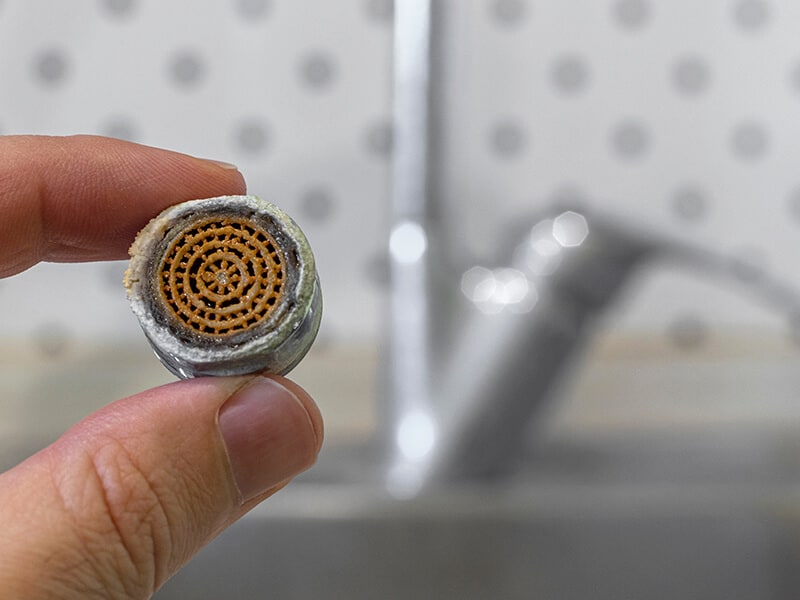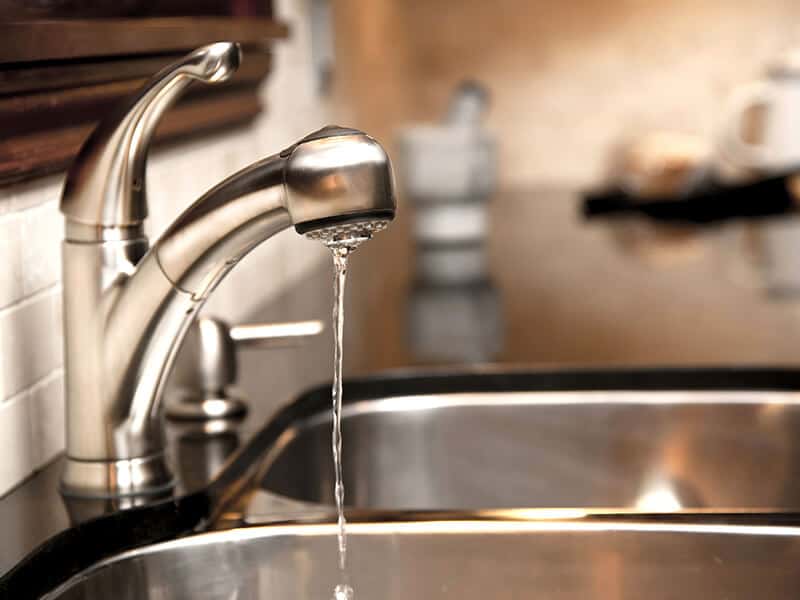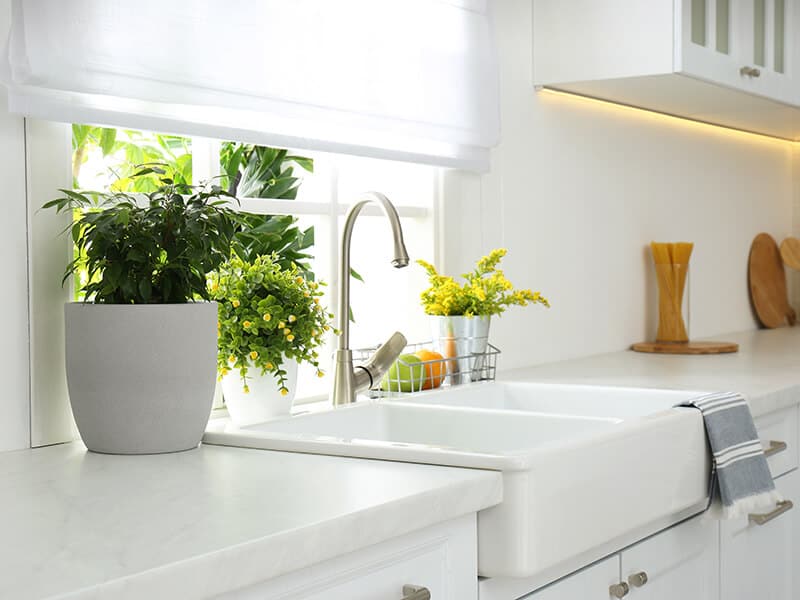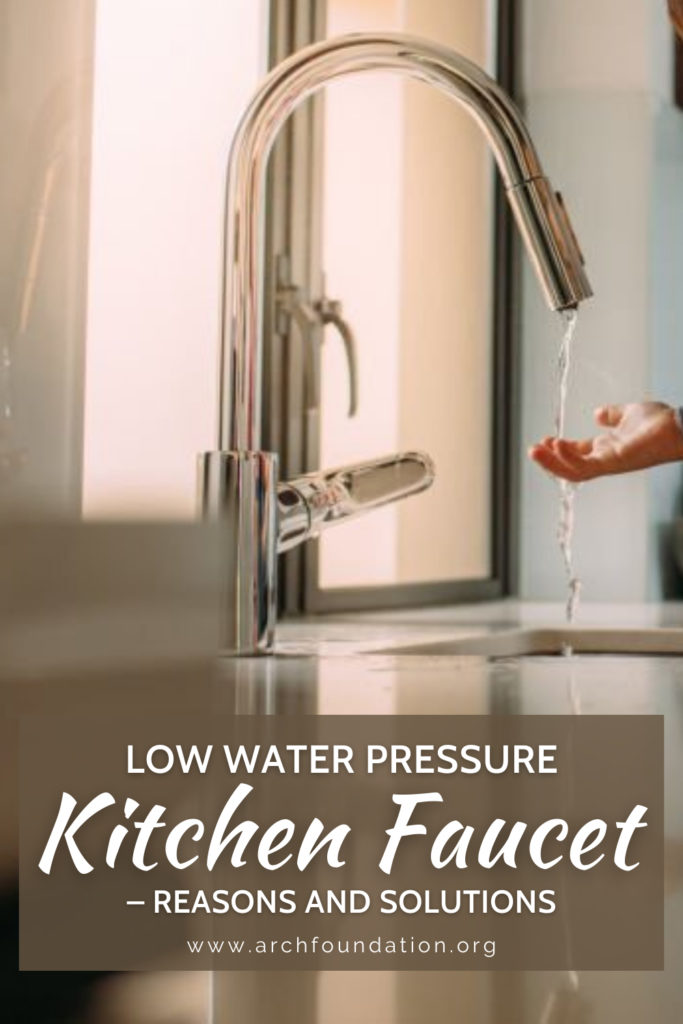Low Water Pressure in Kitchen Faucet – Reasons and Solutions
Are you experiencing low water pressure in kitchen faucet? If you have noticed that your kitchen faucet doesn’t have the pressure it usually has, the first thing to do is to check whether it is only the kitchen faucet or all faucets in your home have the same issue.
When it is a localized issue, there are a couple of things that can affect it. If all the sinks in your home have low pressure, then it can be a general water supply issue.
In that case, you might have to call the plumber, because the issue might be bigger than you think.
On the other hand, the localized issues are caused by some minor problems and you can fix them by yourself. Sometimes, all it takes is a deep clean-up of certain parts or their replacement to get your water pressure to be normal again.
Keep reading to find out more about potential reasons and solutions for low water pressure in the kitchen.

What Causes Low Water Pressure in Kitchen Faucet?
Several things can cause the water pressure in the kitchen faucet to drop.
Those included localized issues that affect only your household, and general issues, which your neighbors also experience.
Localized issues are:
- Clogged aerator
- Clogged cartridge
- Shut-off valve malfunction
- Pressure regulator malfunction
The general issues are:
- City water supply line problems
- Changed water regulations in your area
- Leaking pipes
How to Test Kitchen Faucet Flow Rate?
In most cases, you can determine the low water pressure by your sense and observation. There is a simple test you can do to check the water flow and the water pressure. The two are related because water pressure determines the water flow of your faucet.
In simple words, the higher the pressure, the more water (water flow) is pushed through the faucet.
You’ll need a flow rate bag to complete the test and a timer. You can use the timer you have on your phone. Also, if you experience frequent issues with water pressure, I recommend buying a flow rate bag so you can always identify even the smallest issues and react on time.
Here is how to test the rate.
- Step 1: Put the flow rate bag underneath the faucet. Make sure that the faucet nozzle is completely in the bag to get an accurate reading.
- Step 2: Turn the water on and use a timer to measure 5 seconds before you turn the water off.
If the water runs for five seconds, it will be enough to show you the number of gallons you can get in one minute – GMP. As the water runs, different lines will occur, showing 1.5 GMP, 1.0 GPM, and so on.
- Step 3: Take the bag off the faucet and check the reading. That is all – you know what the flow rate of your faucet is!
Watch this video to know more:
What is Considered a Good Flow Rate for Kitchen Faucets?
Federal regulations specify that a flow rate of a kitchen faucet shouldn’t exceed 2.2 GMP. But, most kitchen faucets have a consistent flow rate between 1.0 and 1.5 GMP. It is enough to provide enough water pressure for all your household needs.
General Water Pressure Issues
If the problem isn’t your faucet, here are a couple of general issues with a water supply that could be the reason behind a low water pressure at the kitchen sink.
Issues with Municipal Water Supplier
If your water supplier has some issues, you wouldn’t be the only one to experience low water pressure. Therefore, check with your neighbors to see if they have similar issues to you.
If they do, a faulty kitchen faucet isn’t the reason. You can contact the water supplier to get more information.
Changed Regulations
If a local government or federal authorities changed some regulations related to the water supply to save water in the drought period, it might cause a low water pressure.
You can call a plumber to install a water pressure booster system to improve the pressure.
Shared Pipelines
Most households share pipelines with their neighbors. Therefore, when your neighbor is using a large amount of water in his home, it might affect the water pressure in your home.
For example, if your neighbor is filling his pool, the chances are that your water pressure will drop until he turns the water off.
Leaking Pipes
Check the basement for a flood if you are suspecting that water pipes are leaking. When you find the leaking pipe, turn the water supply off and use a rubber patch on the leaking spot as a temporary solution.
A rubber patch will prevent further issues. But, call a plumber to get the pipe fixed or replaced.
Kitchen Faucet Issues and How to Fix Them
If nothing on the above isn’t causing the low water pressure, it is time to further explore potential issues with the faucet. Keep reading to find the most common reasons for low water pressure and the quick, DIY solutions that might help.
Clogged Aerator
A clogged aerator is probably the most common reason for low water pressure in the kitchen faucet. Luckily, it is the easiest one to fix too!
An aerator is located at the end of the faucet spout. It maintains the water pressure by dividing the water flow into several streams, divided by air. An aerator is a small metal or plastic mesh that also withholds mineral chunks from going outside of the faucet.
When an aerator clogs, you will experience an immediate pressure drop.
The aerator can get clogged with mineral deposits. Clogged aerators are common issues in households with hard water, with high concentrations of magnesium, chloride, sulfates and other minerals.
Here is how to clean a clogged aerator.
- Step 1: Unscrew the aerator from a kitchen faucet.
- Step 2: Use a toothpick or a toothbrush to clean the mesh.
- Step 3: Put the aerator in a cup filled with white vinegar. Let it sit for at least two hours. It will help prevent mineral deposits in the next couple of months.
- Step 4: Screw the aerator back on the faucet, and turn the water on. Let it run for several seconds so it rinses the vinegar leftovers.
You can clean the aerator every couple of months to maintain its good performance. Or, you can fill the bag with vinegar and tie it to the faucet. It will help break mineral deposits and you don’t have to remove the aerator.
Watch this video to know more:

Clogged Cartridge
If the aerator is clean and the water pressure hasn’t gone back to standard, you need to check the cartridge.
The cartridge is located in the handle. But only faucets with one handle have a cartridge. If your kitchen sink has two handles for hot and cold water, you have a compression faucet.
But, here is a quick way to check the cartridge condition.
- Step 1: Remove the top off the handle. Remove the screws visible in the handle bottom. Now you’ll be able to take the handle off.
- Step 2: The cartridge is ring-shaped and you need to unscrew its cover first. The cartridge is usually plastic or brass, and if it has a lot of debris, it needs to be cleaned.
- Step 3: Unscrew the cartridge and clean it thoroughly. While you are doing that, inspect the o-ring seals. If they have deteriorated, you might need to replace the cartridge to prevent further deterioration.
- Step 4: Put the cartridge back in the handle, screw the cover and the top of the handle.
- Step 5: Turn the water on to see if the water pressure increased. Let the water run for several seconds to stabilize.
Watch this video to know more:
Shut-Off Valve Not Working
Did you have some repairs done around the house? Maybe someone has messed up with the main shut-off and left it partially shut off.
The main shut-off valve is located where the primary municipal pipe enters your home. The valve needs to be fully open to ensure a full water flow.
For example, if you have a gate valve, you will recognize it by wheel-like handles which need to be turned clockwise. A ball valve, another type of valve, has a lever handle, which needs to be placed parallel with the pipe.
The issue with the shut-off valve often occurs after renovation projects or repairs. It is easy to check and fix the reason for low water pressure.
Even if you didn’t have the repairs, check the shut-off valve to ensure you’ll receive the strongest possible water pressure.
Pressure Regulator Malfunction
Does your home have a pressure regulator? If it doesn’t, you can move to the next issue.
Households in towns or areas with high water pressure use devices called pressure regulators. The primary purpose of a pressure regulator is to keep the pressure at the desired level so the water doesn’t damage the pipes in your home.
The optimal water pressure is 50 psi.
Potential reasons for water pressure drop are pressure regulator settings or malfunction. Check the current regulator setting. Try to adjust the settings to 50 psi, and if you fail, you’ll have to hire a plumber.
If the regulator already shows 50 psi and the water pressure dropped, you might need a new device because the current one you have is broken.
Watch this video to know more:
Low Hot Water Pressure Issue
Sometimes, the water pressure on cold water is great, but as soon as you turn on the hot water, it drops. What can be the reason? You can test it by only turning on the hot water.
The most common reason behind low hot water pressure is the issue with a water heater. But, you’ll know for sure that your water heater malfunctions if you notice low water pressure on all faucets – shower, kitchen, sink.
Water heaters also have parts that can get clogged with a mineral deposit, just like aerators. If you have hard water, you should flush your water heaters, both tank, and tankless models. If the mineral deposit isn’t flushed annually, it can pile up over time and affect the water pressure in your faucets when you turn on hot water.
Mineral deposits also increase the water heater energy consumption.
Any plumber can help you flush the mineral sediment inside the water heater and restore its function. If you are unsure whether to flush the heater, listen for the sounds coming from it. You should hear dull sounds – tup-tup if the water heater is filled with mineral sediment.
But, if you haven’t flushed your water heater for years, flushing may not work. You’ll have to replace the water heater to restore the old water pressure.
Regular maintenance of a water heater can increase its lifespan and ensure great performance over the years.

Frequently Asked Questions
No one has ever started a conversation with: How’s your water pressure in the kitchen? Therefore, it is normal to have many questions and unresolved issues related to low water pressure.
Hopefully, the next section answers the most important questions about the kitchen faucet pressure issue. If you have more questions, ask me in the comments!
Don’t Call a Plumber for Minor Issues – Fix them Yourself
Plumbing services are expensive, especially if you have to call a plumber now and then to fix some minor issues.
Low pressure in the kitchen faucet isn’t rocket science. You can easily troubleshoot for several most common reasons, such as clogged parts and closed valves. Instead of calling a plumber, try to fix them yourself using the advice from above.
Please let me know if my hacks worked!
If you found the article useful, please consider hitting the like button!

